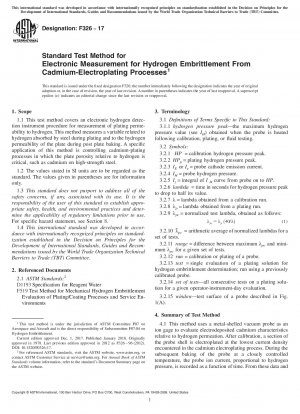ASTM F326-17
Standard Test Method for Electronic Measurement for Hydrogen Embrittlement From Cadmium-Electroplating Processes
- Standard No.
- ASTM F326-17
- Release Date
- 2017
- Published By
- American Society for Testing and Materials (ASTM)
- Status
- Replace By
- ASTM F326-23
- Latest
- ASTM F326-23
- Scope
-
5.1 Hydrogen is evolved during metal electrodeposition in aqueous baths. Some of this hydrogen enters parts during plating. If the absorbed hydrogen is at a level presenting embrittlement hazards to high-strength steel, it is removed by baking parts after plating to expel this hydrogen. However, the lack of plate porosity itself may block hydrogen egress. Thus, it becomes important to know both the relative amount of hydrogen absorbed and the plate porosity.
5.2 This test provides a quantitative control number for cadmium plate porosity that can be used to control a cadmium plating process and the status of cadmium-plated hardware. It can also be used for plating process troubleshooting and research and development to determine the effects on plate porosity by process variables, contaminants, and materials. When used to control a critical process, control numbers for plate porosity must be determined by correlation with stress rupture specimens or other acceptable standards.
5.3 There is no prime standard for plate porosity. For this reason, two ovens must be used, with tests alternated between ovens. Data from the ovens are compared to ensure no equipment change has occurred.
1.1 This test method covers an electronic hydrogen detection instrument procedure for measurement of plating permeability to hydrogen. This method measures a variable related to hydrogen absorbed by steel during plating and to the hydrogen permeability of the plate during post plate baking. A specific application of this method is controlling cadmium-plating processes in which the plate porosity relative to hydrogen is critical, such as cadmium on high-strength steel.
1.2 The values stated in SI units are to be regarded as the standard. The values given in parentheses are for information only.
1.3 This standard does not purport to address all of the safety concerns, if any, associated with its use. It is the responsibility of the user of this standard to establish appropriate safety, health, and environmental practices and determine the applicability of regulatory limitations prior to use. For specific hazard statement, see Section 8.
1.4 This international standard was developed in accordance with internationally recognized principles on standardization established in the Decision on Principles for the Development of International Standards, Guides and Recommendations issued by the World Trade Organization Technical Barriers to Trade (TBT) Committee.
ASTM F326-17 Referenced Document
- ASTM D1193 Standard Specification for Reagent Water
- ASTM F519 Standard Test Method for Mechanical Hydrogen Embrittlement Evaluation of Plating Processes and Service Environments
ASTM F326-17 history
- 2023 ASTM F326-23 Standard Test Method for Electronic Measurement for Hydrogen Embrittlement From Cadmium-Electroplating Processes
- 2017 ASTM F326-17 Standard Test Method for Electronic Measurement for Hydrogen Embrittlement From Cadmium-Electroplating Processes
- 1996 ASTM F326-96(2012) Standard Test Method for Electronic Measurement for Hydrogen Embrittlement From Cadmium-Electroplating Processes
- 1996 ASTM F326-96(2006) Standard Test Method for Electronic Measurement for Hydrogen Embrittlement From Cadmium-Electroplating Processes
- 1996 ASTM F326-96(2001)e2 Standard Test Method for Electronic Measurement for Hydrogen Embrittlement from Cadmium-Electroplating Processes
- 1996 ASTM F326-96(2001)e1 Standard Test Method for Electronic Measurement for Hydrogen Embrittlement from Cadmium-Electroplating Processes
- 2001 ASTM F326-96 Standard Test Method for Electronic Measurement for Hydrogen Embrittlement from Cadmium-Electroplating Processes
